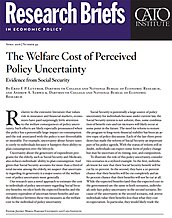Uncertainty about the generosity of expenditure programs for the elderly, such as Social Security and Medicare, also reduces individuals’ ability to plan consumption. And given that Social Security accounts for more than a third of total income among the elderly, we suspect that uncertainty regarding its generosity is a major source of the welfare cost of policy uncertainty more generally.
Our research uses a novel approach to estimate the cost to individuals of policy uncertainty regarding Social Security benefits: we elicit both the expected benefits and the certainty equivalent of uncertain future benefits and use the difference between these two measures as the welfare cost to the individual of policy uncertainty.
Social Security is potentially a large source of policy uncertainty for individuals because under current law, the Social Security system is not solvent; thus, some combination of benefit cuts and tax increases will likely occur at some point in the future. The need for reform to restore the program to long-term financial stability has been an active topic of policy discussion. Each of the last three presidents has made the reform of Social Security an important part of his policy agenda. With the status of reform still in doubt, individuals can expect some form of policy change but may be uncertain of its timing, size, and composition.
To illustrate the role of this policy uncertainty, consider two scenarios in a stylized example. In the first, individuals know for sure that their Social Security benefit will be cut by 20 percent. In the second, they have a 20 percent chance that their benefits will be cut completely and an 80 percent chance that their benefits will not be cut at all. While the expected benefits (and thus the expected cost to the government) are the same in both scenarios, individuals only face policy uncertainty in the second scenario. Because of the uncertainty in the second scenario, risk averse individuals value their benefits less than what they cost in expectation. In particular, they would likely trade the second scenario for a sure benefit cut, even if that sure benefit cut is somewhat greater than 20 percent. The difference between the expected benefit cut and the largest sure benefit cut people would be willing to accept is an estimate of the cost to individuals of policy uncertainty surrounding Social Security benefits.
We quantify this cost of policy uncertainty by fielding an original, internet-based survey of 3,000 individuals between the ages 25 and 59 who are broadly representative of the U.S. population in that age range. We focus on this age range because this is the prime age range in which individuals need to prepare for retirement and because older individuals will likely be grandfathered into the existing rules if there is a major Social Security reform. An important innovation relative to the literature that examines perceptions of future Social Security benefits is that we ask about future benefits relative to the benefits scheduled under current law. This allows us to filter out any uncertainty (or misperceptions) regarding the current benefit rules as well as uncertainty about benefits that is related to uncertain inputs (such as own future earnings or aggregate future wage growth) to the benefit formula.
The key part of the survey consists of two sets of questions about people’s future Social Security benefits. In the first, respondents are asked to describe the likelihood of receiving benefits in specific ranges relative to “the benefits they are supposed to get under current law.” They fill in a histogram of this distribution by putting balls into bins on their computer screens. This histogram allows us to calculate their expected benefits. In the second part, respondents are asked to make a sequence of choices as to whether they would prefer a guaranteed contract at a hypothetical percentage of the benefits they are supposed to get under current law to the distribution of benefits they think they will get. This sequence of questions allows us to bracket their certainty equivalent benefit level. Subtracting the certainty equivalent from the expected benefits yields the respondent’s risk premium against policy uncertainty.
Our main results indicate that individuals perceive the risk to which policy uncertainty exposes them and that the welfare cost of that risk is statistically and economically significant. Across respondents, the average expected benefits are 59.4 percent of the benefits the respondents are supposed to get under current law. The average certainty equivalent is 53.7 percent, yielding an average risk premium of 5.8 percent. At 7.0 percent, the median risk premium is close to the average risk premium. These risk premia are expressed as percentage of benefits under current law, but would become 9.7 percent and 11.8 percent, respectively, if expressed as a percentage of expected benefits.
Our results show that the risk premium is higher when people are more dependent on Social Security or have less time to mitigate uncertainty in Social Security by changing their labor supply or savings rate. For example, older people and those with lower incomes have higher risk premia. Given the large role that Social Security plays in retirement, our research suggests that a considerable welfare gain is possible by finding ways to reduce uncertainty about its eventual reform. Some possibilities include acting sooner rather than later, or legislating rules in which benefits automatically adjust to macroeconomic and demographic changes to keep Social Security solvent.
Note
This research brief is based on Erzo F. P. Luttmer and Andrew A. Samwick, “The Welfare Cost of Perceived Policy Uncertainty: Evidence from Social Security,” National Bureau of Economic Research Working Paper no. 21818, December 2015, http://www.nber.org/papers/w21818.
